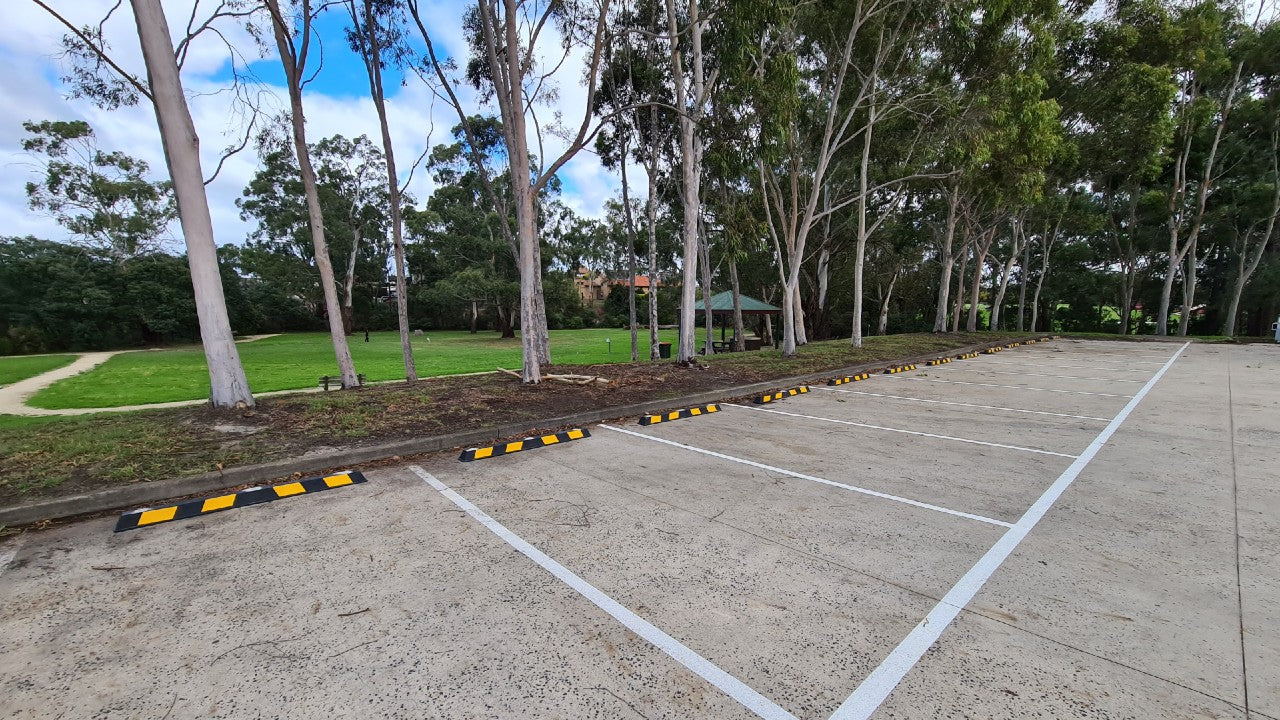If you’re building or refurbishing a car park, one of the essential elements will be installing new, durable wheel stops. Whether commercial, residential, or industrial, your parking area will benefit from wheel stops to control and direct people to park safely and orderly.
Wheel stops are used for limiting or controlling the travel of a vehicle into a parking space. They create a physical barrier that wheels hit against and can’t pass beyond. In car parks where the kerb is higher than 100mm, wheel stops are required to stop the front or back skirts of legal height vehicles from becoming damaged. This is also why car park wheel stops in commercial and residential environments should not have wheel stops that are higher than 100mm.
Where should you position wheel stops?
Wheel stops should be positioned at the back of a car parking space at a safe distance from the perimeter so that front or rear-in parking vehicles can fit within the space safely. The best distance from the perimeter can change depending on the nearby kerb height or wall and expected vehicle tyre types.
You should start measuring the distance between the wheel stop and the kerb from the point of contact with the vehicle tyre.
Wheel stop placement:
Low kerbs:
- Distance from kerb for front-in car spaces: 620mm
- Distance from kerb/wall for rear-in car spaces: 900mm
High kerbs:
- Distance from kerb for front-in car spaces: 820mm
- Distance from kerb/wall for rear-in car spaces: 1100mm
Important notes:
- If the kerb height exceeds 150mm or if the car space backs onto a wall, you should add another 200mm to the distance.
- Under Australian Standard AS2890.1: 2004, wheel stops should be between 90mm and 100mm in height. You may find many styles of concrete wheel stops exceed this height. To ensure that you get high quality and durable car park wheel stops that are in line with regulations, take a look at our wheel stops on offer.
- Wheel stops should be avoided if they will be in the path of pedestrians as they move to and from parked vehicles, or when crossing a car park. There should always be clear indication of pedestrian zones and car park spaces.
Common wheel stop uses
Wheel stops are required in a range of car park environments, from shopping centres, supermarkets, undercover and underground car parks, and retail precincts, to private garages and public environments.
Some car park operators think that if they have concrete kerbs they do not need to worry about wheel stops. However they are required to protect both the car and the ker (along with pedestrians) from encroaching on the kerb.
Wheel stops are commonly used to:
- Control vehicle overhanging the kerb where it is hazardous or restrictive to pedestrians.
- Stop vehicle contact with an end barrier or high kerb.
- Stop any encroachment into an opposing parking space.
There are a range of wheel stops that can be used in a variety of environments and for different types of vehicles, including cars and light vehicles, as well as trucks and heavy vehicles. The location and purpose of your car park will determine the types of wheel stops you need, as regular wheel stops may not be suitable for trucks, and vice versa.
Types of wheel stops
There are a variety of wheel stop and wheel items that are used to stop or control the movement of vehicles. Let’s take a closer look at the common types of wheel stops that we offer:
Car Wheel Stops: Perfect for most car parks in a public and commercial setting, car wheel stops are designed to suit most light vehicles and legal vehicle heights. The best options are plastic, poly, or rubber wheel stops for a durable and long lasting solution.
Truck Wheel Stops: Heavy vehicle and machinery will require higher and more robust wheel stops to withstand greater impact and weights. Specially designed truck wheel stops are ideal for ensuring safety and convenience in industrial car parks and other areas like truck stops and rest areas. They are generally made from heavy-duty recycled plastic to ensure they can withstand the harsh climate and heavy use.
Chocks, Strips, Mats & Lane Dividers: There are a range of other wheel stop items such as wheel chocks to stop tyres rolling, rumble strips to moderate speed, wheel mats to lock wheels in place, and lane dividers to stop vehicles from entering another lane.
To find out more about these types of wheel stops, take a look at our blog The Different Types Of Wheel Stops.
If you have any questions regarding our car park wheel stops, or wheel stop installation or placement, reach out to our friendly team of experts here.

